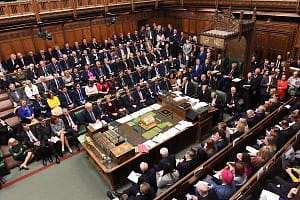1.8m workers earning the National Living Wage (NLW) will receive an additional £690 over the year from today, as the biggest ever increase to NLW comes into effect.
The National Minimum Wage (NMW) is also increasing. This includes £7.70 per hour for 21 to 24-year olds, providing an additional £580 over the year for full-time workers, and £6.15 for 18 to 20-year olds, providing full-time workers with an additional £455 over the year. Taken together with changes to NLW, 2.1m people will be receiving a pay increase from today, with workers in the retail and hospitality sectors due to benefit the most.

Business minister Kelly Tolhurst said, “We are committed to making sure that UK workers get a fair day’s pay and the rise in the National Living and Minimum Wage, benefiting millions of people, delivers on this commitment.
“Since the National Living Wage was announced in 2015, it has helped protect the lowest paid – increasing faster than inflation and average earnings. Our minimum wage rates are among the highest in the world and, through our modern Industrial Strategy, we are determined to end low pay and workers get a fair day’s pay for a fair day’s work.”
Low pay commission Chair Bryan Sanderson said, “We are pleased that millions of workers across the country will see an above-inflation pay rise as a result of today’s minimum wage increases, which follow the recommendations the LPC made in the autumn.
>>t
“Today is particularly significant as it also marks 20 years of the National Minimum Wage. Over the last 20 years the NMW and more recently the NLW have achieved their goal of raising pay without significant negative effects on employment.”
The UK’s minimum wage is currently growing faster than other countries with similar or higher minimum wage, such as Belgium, France and Germany.
The Government aims to end low pay and later this year will announce the independent Low Pay Commission’s remit after 2020. At Spring Statement, Ministers also announced that the world-leading academic Professor Arin Dube will lead a review of the impact of minimum wages internationally.
Wage increases follow hot on the heels of the biggest increase to workers’ rights in a generation, launched in 2018, and are a vital aspect of the modern Industrial Strategy.
As part of this, on 6 April all workers, including casual and zero-hour workers, will have the right to receive a payslip and the maximum employment tribunal fines for employers will quadruple from £5,000 to £20,000.
| Age | 2019-20 (new rate) | 2018-19 (previous rate) |
| 25 and over | £8.21 | £7.83 |
| 21 to 24 | £7.70 | £7.38 |
| 18 to 20 | £6.15 | £5.90 |
| Under 18 | £4.35 | £4.20 |
| Apprentice | £3.90 | £3.70 |
- Number of workers paid NMW / NLW rates in April 2019
| Region | No. of workers receiving NLW | No. of workers receiving NMW |
| North West | 222,000 | 46,000 |
| South East | 188,000 | 31,000 |
| West Midlands | 181,000 | 33,000 |
| Yorkshire & Humber | 172,000 | 37,000 |
| London | 167,000 | 17,000 |
| East Midlands | 157,000 | 36,000 |
| East | 151,000 | 26,000 |
| South West | 138,000 | 30,000 |
| Scotland | 128,000 | 31,000 |
| Wales | 95,000 | 19,000 |
| North East | 88,000 | 19,000 |
| Northern Ireland | 75,000 | 20,000 |
- Number of workers paid NMW / NLW rates by low paying sector
| Sector | No. of workers receiving NLW | No. of workers receiving NMW |
| Non-low paying sectors | 351,000 | 56,000 |
| Retail | 343,000 | 86,000 |
| Cleaning and maintenance | 255,000 | 6,000 |
| Hospitality | 246,000 | 101,000 |
| Social care | 105,000 | 9,000 |
| Transport | 69,000 | 7,000 |
| Storage | 65,000 | 7,000 |
| Food processing | 63,000 | 4,000 |
| Childcare | 58,000 | 15,000 |
| Non-food processing | 58,000 | 9,000 |
| Office work | 47,000 | 9,000 |
| Hair and beauty | 25,000 | 14,000 |
| Leisure | 24,000 | 12,000 |
| Agriculture | 19,000 | 3,000 |
| Security and enforcement | 17,000 | 1,000 |
| Textiles | 8,000 | – |
| Call centres | 7,000 | 1,000 |






Leave a Comment